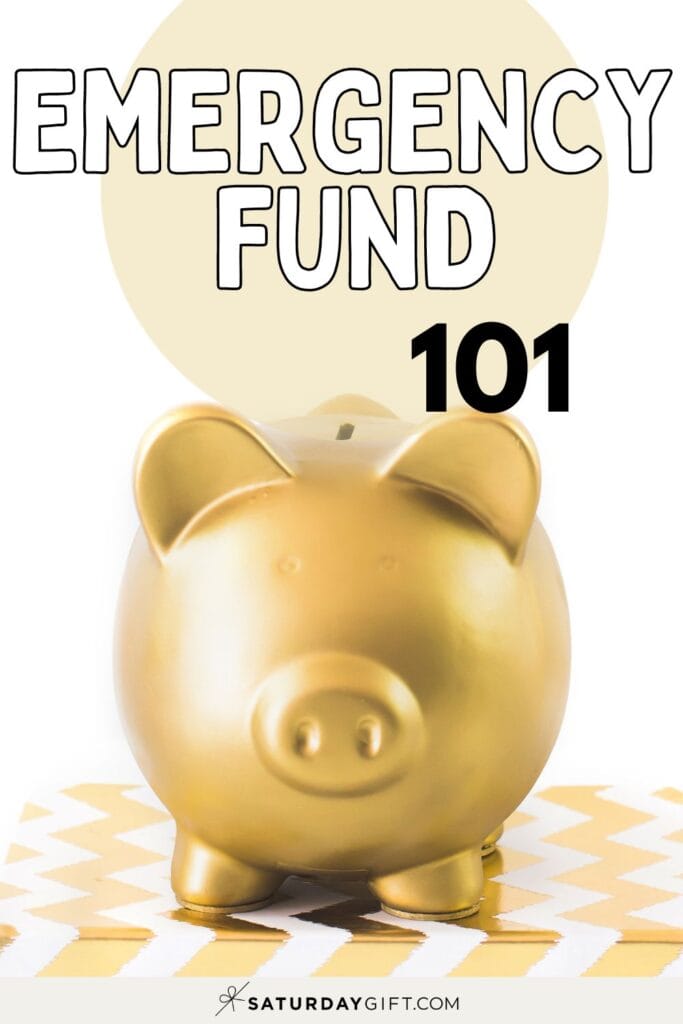Emergency Fund 101 – How to Save For a Rainy Day
This post may contain affiliate links, which means I’ll receive a commission if you purchase through my links, at no extra cost to you. Please read full disclosure for more information.
Ready to save for a rainy day and create an emergency fund? Here’s everything you need to know to get started.

In the unpredictable journey of life, financial stability can often feel elusive.
Unexpected expenses, job losses, or medical emergencies can strike without warning, leaving us scrambling for solutions. And that’s where emergency savings become a financial lifesaver.
Here’s a comprehensive guide about the importance of an emergency fund, how to build one, and best practices for maintaining it.
Disclaimer: The content provided is for informational purposes only and should not be considered financial advice. Consult a financial professional for personalized guidance on budgeting and managing your finances.
What is an emergency fund
An emergency or rainy day fund is a cash reserve or a dedicated bank account (usually a savings account through a bank or credit union) set aside specifically to cover unexpected expenses or financial emergencies.
This fund acts as a financial cushion, ensuring that you can manage life’s surprises without derailing your financial stability or going into debt.
Usually, the recommended amount for an emergency fund is three to six months‘ worth of expenses, including rent/mortgage, utilities, groceries, transportation, and other essential bills.
However, your exact amount may vary depending on your lifestyle and financial obligations.
Why is emergency fund important
Here are a few reasons why you need an emergency fund
- Financial Security: An emergency fund can provide peace of mind, knowing you have a financial safety net.
- Avoid Debt: Saving for a rainy day helps you avoid high-interest debt from credit cards or loans when something unexpected happens.
- Flexibility: You can handle emergencies, like long-term investments or retirement funds, without disrupting your financial goals.
- Job Loss: Provides a buffer in case of unemployment or reduced income.
- Unexpected expenses: Life happens, whether it’s a car breakdown, home repair, or medical bills. Unexpected expenses can put a strain on your budget. An emergency fund provides the necessary funds to cover these costs without having to dip into your regular savings or go into debt.
When can you use the emergency funds
The emergency account is meant for true emergencies.
Emergencies refer to unexpected and essential expenses that you cannot plan for.
These can include:
- Medical Emergency: Unexpected medical bills or accidents.
- Job Loss: Getting laid off, furloughed, or a significant reduction in income.
- Car Repairs: Essential vehicle repairs to get to work or handle emergencies.
- Home Repairs: Urgent repairs such as a leaky roof or broken furnace.
- Family Emergencies: Unexpected expenses related to family emergencies (e.g., flying to see an ill family member).
It’s important to note that you should not use the emergency savings account for non-essential expenses or splurges. It’s crucial to reserve this fund strictly for emergencies to ensure its sustainability and effectiveness.
How much should you save?
The ideal size of your emergency fund depends on your personal circumstances. Here are some general guidelines:
- Initial Goal: Start with a goal of $1,000. This amount can cover minor emergencies and gives you a starting point.
- Three to Six Months of Expenses: Aim to save three to six months’ worth of household expenses. This range covers most major emergencies, such as job loss or significant medical bills.
- Personalized Amount: Consider your job stability, health, and other factors. Aim for a larger fund if you have a more volatile income or higher expenses.
RELATED PAGE: Emergency Fund Calculator
Even though the general rule of thumb is to save three to six months’ living expenses in your emergency fund, the amount can vary depending on your financial situation and risk tolerance.
Here are some factors to consider when determining the right amount for your emergency fund:
- Monthly Expenses: Calculate your spending on essential expenses such as rent/mortgage, utilities, groceries, and insurance. Include only the “need to have” – things you can’t survive without.
- Job Security: If you have a stable job with a consistent income, you can aim your emergency fund to cover three to four months of your living expenses. If your job is less secure, aim for a higher amount.
- Risk Tolerance: Consider how comfortable you are with financial risk and adjust your emergency fund accordingly.
RELATED POST: Bill Organizer Template – 39 Cute & Free Printable Bill Trackers
How to guild an emergency fund
Building an emergency fund takes time and effort, but the benefits are worth it. Here’s a step-by-step guide to help you get started:
1) Set a goal
Decide how much you want to save for your emergency fund.
2) Create a monthly budget
Track your expenses and daily cash flow and identify areas where you can cut back to save more.
RELATED POST: 37 Budget Planners & Trackers – Cute & Free Printables
3) Automate your savings
Set up automatic monthly transfers from your checking account to your emergency fund. When you save automatically a portion of your income, you won’t even miss the money.
4) Save windfalls
Any unexpected bonus, tax refund, or cash gifts can go straight into your emergency fund.
RELATED POST: Savings Tracker Printable – 51 Cute & Free Templates
5) Make extra income
Consider starting a side hustle or finding ways to increase your income to save more for emergencies.
RELATED POST: Income Tracker Printable – 19 Cute & Free Printable Templates
6) Reduce expenses
Find ways to cut back on non-essential expenses, such as dining out, splurging, or unused subscription services.
RELATED POST: Expense Tracker Printable – 26 cute & Free Spending Logs
Where to keep your emergency fund
- High-Yield Savings Account:
- Keep your emergency fund in a high-yield savings account. These accounts help your money grow over time because they offer better interest rates than regular savings accounts.
- Money Market Accounts:
- Money market accounts are another option, offering competitive interest rates with check-writing privileges.
- Avoid Investment Accounts:
- Your emergency fund should be easily accessible. Avoid investing it in stocks or other volatile assets that can lose value quickly.
Maintaining your emergency fund
- Regularly Review Your Fund:
- Periodically assess your emergency fund to ensure it aligns with your current expenses and financial goals.
- Adjust the target amount as your financial situation changes (new job, increased expenses, etc.).
- Replenish After Use:
- If you need to use your emergency fund, prioritize replenishing it as soon as possible. Go back to your savings plan and budget to restore the balance.
- Avoid Using It for Non-Emergencies:
- Discipline is key. Use your emergency fund strictly for true emergencies, not for regular expenses or discretionary spending.
- Adjust for Inflation: As time passes, the cost of living will increase. Consider adjusting your emergency fund target amount to account for inflation.
Emergency fund tips for success
- Stay Motivated:
- Keep your goal in mind and remind yourself of the peace of mind an emergency fund provides.
- Celebrate milestones along the way to stay motivated.
- Involve Your Family:
- Discuss the importance of an emergency fund with your family. Everyone should be on the same page about its
purpose and the need to maintain it.
- Discuss the importance of an emergency fund with your family. Everyone should be on the same page about its
- Use Financial Tools:
- Utilize budgeting printables, apps, and tools to track your
progress and manage your finances efficiently.
- Utilize budgeting printables, apps, and tools to track your
Printable emergency fund tracker
To help you stay motivated, we’ve created a printable emergency fund tracker. This tool allows you to mark your
This post offers multiple options. Go to the post, choose your favorite, and download and print it for free.

POST: 25 Cute & Free Emergency Fund Tracker Printable Templates
Conclusion
Building and maintaining emergency funds is one of the most important steps you can take to secure your financial well-being.
It requires discipline, planning, and a commitment to saving to a dedicated account, but the benefits far outweigh the effort.
Following this guide, you can create a robust safety net to protect you and your loved ones from financial emergencies, providing peace of mind and stability in an uncertain world.
Start today, and take the first step towards financial resilience. Your future self will thank you.


